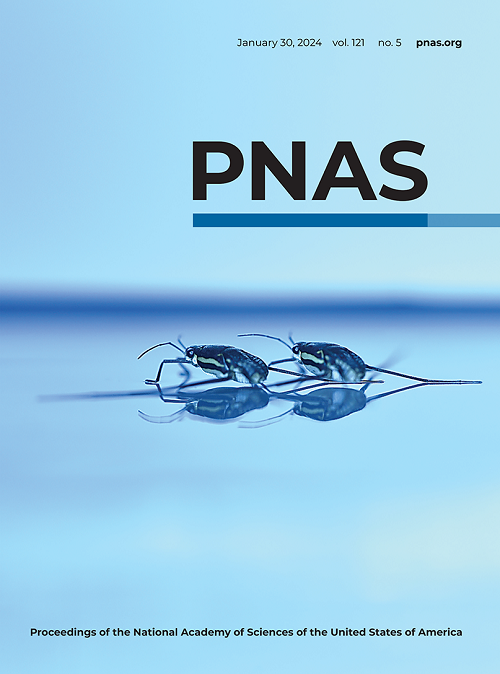通过原型组氨酸激酶直接感知宿主铁介导肠道病原体的毒力
IF 9.4
1区 综合性期刊
Q1 MULTIDISCIPLINARY SCIENCES
Proceedings of the National Academy of Sciences of the United States of America
Pub Date : 2025-06-04
DOI:10.1073/pnas.2507874122
引用次数: 0
摘要
双组分系统(TCS)组氨酸激酶使细菌病原体能够感知环境信号并在感染期间调节适应性反应。EnvZ/OmpR TCS因其在细菌外膜孔蛋白渗透压/ ph依赖性调节中的作用而闻名,也是一种主要的毒力调节剂。然而,激活EnvZ/OmpR触发致病性的环境线索仍然不清楚,限制了我们对宿主-病原体相互作用的理解。在这里,我们证明了副溶血性弧菌(一种与海鲜相关的胃肠炎的主要病原体)中,EnvZ作为一种直接的三铁(Fe 3+)传感器来控制毒力程序。fe3 + -EnvZ相互作用触发激酶磷酸化和激活,从而实现生物膜形成、蜂群运动和3/6型分泌系统的转录控制。铁结合缺陷的EnvZ突变体(EnvZ Q103A)取消了铁3+的响应性和下游信号通路。在幼兔感染模型中,铁3+通过EnvZ/OmpR信号增强副溶血性弧菌的肠道定植和毒力。本研究确定fe3 +是激活EnvZ/OmpR毒力调控的生理配体,并为肠道病原体如何利用宿主来源的铁信号促进感染提供了见解。本文章由计算机程序翻译,如有差异,请以英文原文为准。
Direct sensing of host ferric iron by an archetype histidine kinase mediates virulence of an enteric pathogen
Two-component system (TCS) histidine kinases enable bacterial pathogens to sense environmental signals and regulate adaptive responses during infection. The EnvZ/OmpR TCS, known for its role in osmolarity/pH-dependent regulation of outer membrane porins across bacterial species, is also a central virulence regulator. However, the environmental cues that activate EnvZ/OmpR to trigger pathogenicity have remained unclear, limiting our understanding of host–pathogen interactions. Here, we demonstrate that in Vibrio parahaemolyticus , a major etiological agent of seafood-associated gastroenteritis, EnvZ functions as a direct ferric iron (Fe 3+ ) sensor governing virulence programs. Fe 3+ -EnvZ interaction triggers kinase phosphorylation and activation, enabling transcriptional control of biofilm formation, swarming motility, and type 3/6 secretion systems. An iron-binding-deficient EnvZ mutant (EnvZ Q103A ) abrogated Fe 3+ responsiveness and downstream signaling pathways. In an infant rabbit infection model, Fe 3+ enhanced V. parahaemolyticus intestinal colonization and virulence through EnvZ/OmpR signaling. This study identifies Fe 3+ as the physiological ligand activating the EnvZ/OmpR virulence regulon and provides insight into how enteric pathogens exploit host-derived iron cues to promote infection.
求助全文
通过发布文献求助,成功后即可免费获取论文全文。
去求助
来源期刊
CiteScore
19.00
自引率
0.90%
发文量
3575
审稿时长
2.5 months
期刊介绍:
The Proceedings of the National Academy of Sciences (PNAS), a peer-reviewed journal of the National Academy of Sciences (NAS), serves as an authoritative source for high-impact, original research across the biological, physical, and social sciences. With a global scope, the journal welcomes submissions from researchers worldwide, making it an inclusive platform for advancing scientific knowledge.

 求助内容:
求助内容: 应助结果提醒方式:
应助结果提醒方式:


